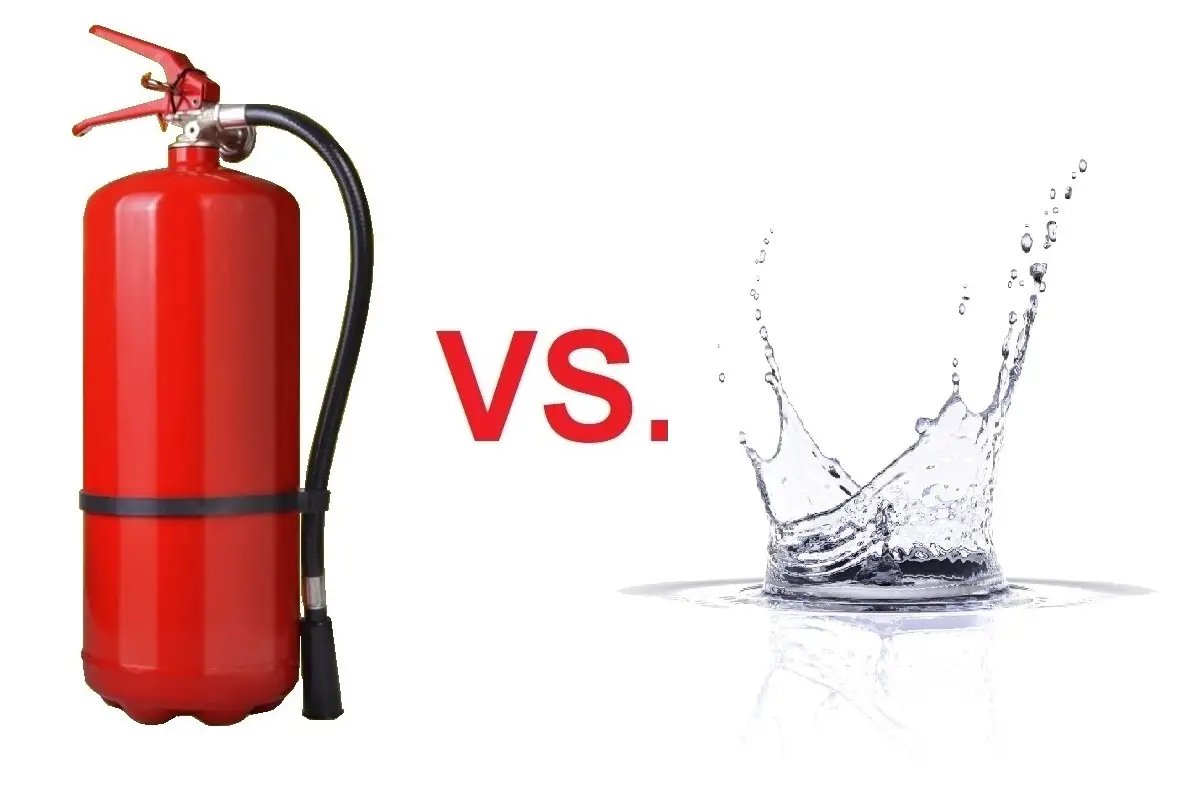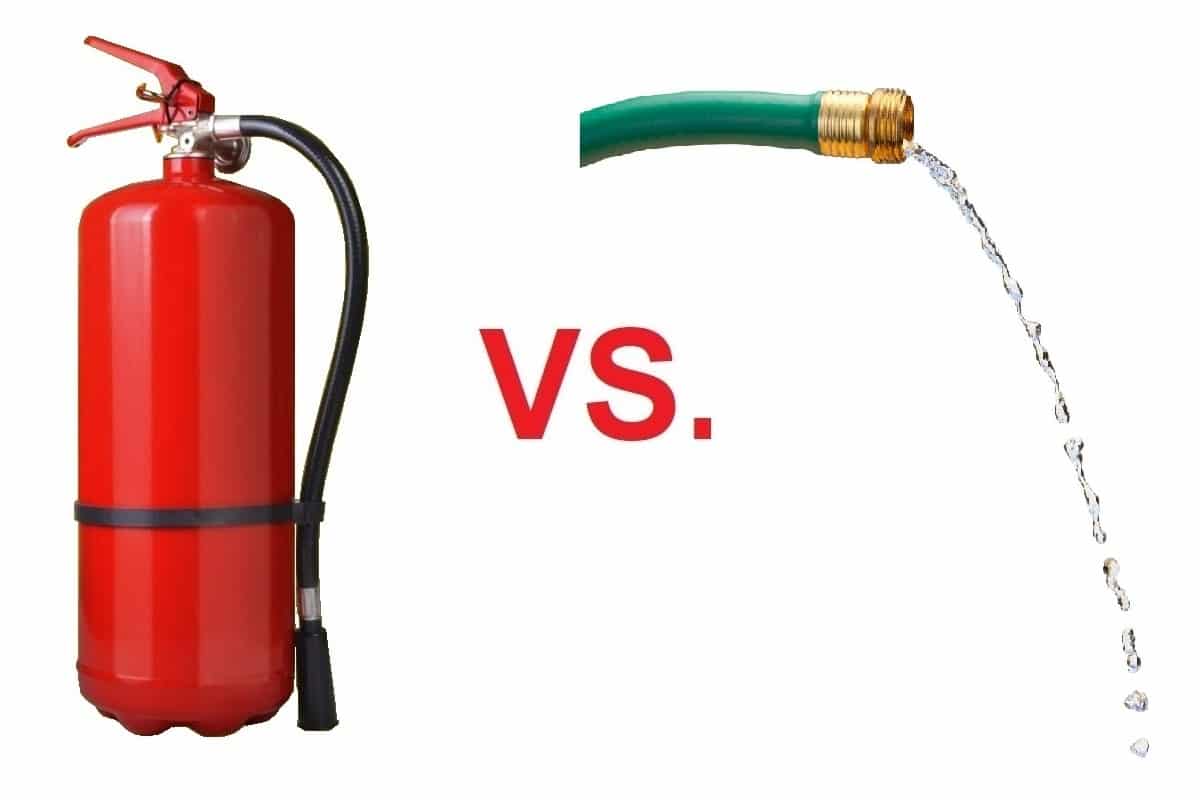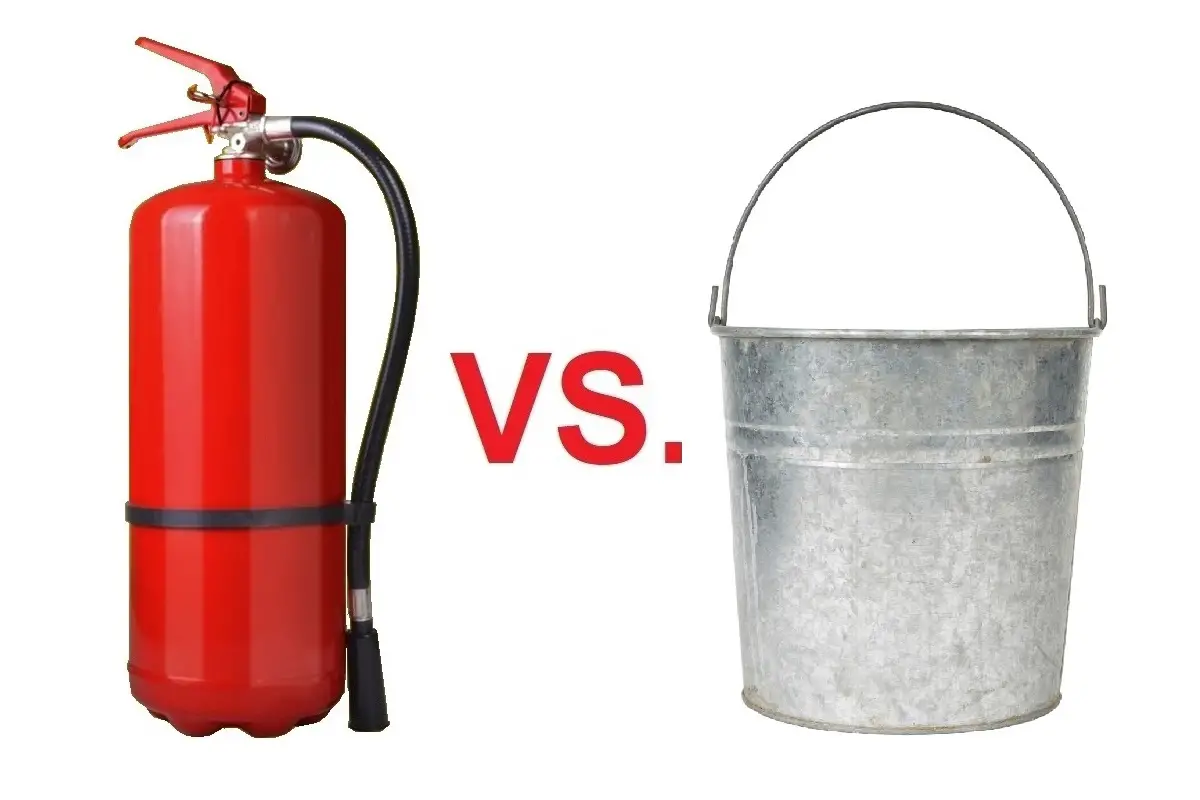Water has been used to extinguish fires all the way back through human history. Specialized fire extinguishers have existed in various forms for slightly less time. So, which one is more effective at putting out fires? Find out in this post.
How Does Water Extinguish Fires?
Fires require fule, oxygen, and heat to remain active. The primary way water extinguishes fire is by removing the heat by absorbing it. This puts the fire out.
Water has strong molecular bonds, and will not breakdown into oxygen and hydrogen unless it is heated to 212 degreese Farhrenheit (water’s boiling point). A fire will not be able to sustain high enough heat to turn water into gas when enough water is poured on top of it.
Another way water extinguishes fire is by simply smothering it. It will form a solid shield from the fire and air, which starves the fire of oxygen.

Can Water Extinguish All Types of Fires?
No. Water is not good at extinguishing electrical, grease, liquid oil, or metal fires. For these types of fires, using water can make the fire worse.
How Much Water Is Needed To Put Out a Fire?
This is a complicated question. For small ordinary class A fires, spraying a fire with a hose or pouring a one gallon bucket of water onto it, will likely extinguish it. However, for building fires, much more water is needed.
The ISO (ISO – International Organization for Standardization) provides a special formual for estimating the amount of water needed to fight a fire that starts in a building that lacks a sprinkler system. This is:
NFF = (Ci)(Oi)[(1.0+(X+P)i] where:
NFFi = water flow needed (GPM)
Ci = unit factor for type of construction
Oi =unit factor for type of occupancy
X = unit factor for exposed buildings
P = unit factor for communication between buildings
However, this equation is really only useful for preplanning a building prior to a fire breaking out.
The National Fire Academy provides an easier fire flow formula:
L x W/3 = GPM where:
L = Length
W= width
GPM is the needed fire flow in gallons per minute.
Fire fighters often use this formula which is much easier to do on location at 2 A.M. fires. It will be obvious when more water is needed, as the fire will not go out.
When Do Fire Departments Use Water?
Yes, in fact fire department mostly use water to put out house and building fires. They usually use water from a fire hydrant, which is connected to the city’s water supply.
Other fluids and chemicals fire fighters use include, foam, dry chemicals, dry powders, wet chemicals, and Carbon Dioxide (CO2).
Water Vs. Fire Extinguisher Cost
Water is a very inexpensive way of fighting a fire. Tap water in the United States only costs about $0.01 US Dollars (one penny) for 5 gallons (20 liters). It is also very easy to access and abundant.
However, an ordinary ABC 5 lb. fire extinguisher can cost between $30-$100+ USD to purchase.
So, using water to put out a fire is much cheaper than using a standard fire extinguisher, but may be less effective in some situations.
Fire Extinguisher vs. Garden Water Hose

Fire Extinguishers Vs. Garden Hoses On Outdoor Fires
Garden hoses are really only useful on small fires at ground level. If the exterior of your house is on fire, a garden hose may not be enough to have any real impact. At this point, the fire department needs to be called and the premises evacuated.
If you have a grease fire outdoors, such as with a barbecue fire, then it’s critical that you use a fire extinguisher, rather than water from a garden hose or bucket.
Garden Hose Length and Spray Distance
Garden hoses come in various lengths, which range from 15 ft. to over 100 ft. They are usually 5/8 inch in diameter, but can be 3/4 inch in diameter.
A garden hose, without a sprayer attachment and running water at full, can spray between 3-6 feet. If it is held with a finger or thumb, it can spray a bit further.
A garden hose with a sprayer can reach between 10-30 feet depending on the type. This may be enough to reach the roof line on single story house.
This is opposed to a standard ABC dry chemical fire extinguisher that can reach between 12-18 feet for up to 15 seconds.
Garden Hose Vs. Fire Extinguisher Cost
Garden hoses range in cost from $15 USD (for shorter hoses) up to $80 (for large diameter farm hoses). Fire extinguishers cost a bit more, between $30-100+ USD each.
Fire Extinguisher vs. Water Bucket
A bucket of water is useful for extinguishing small class A and B fires (paper, wood, petroleum). Water is not safe to use on electrical or grease fires, which can actually make them worse.

How Do Water Buckets Put Out Fires?
Buckets are useful for putting out fires because all of their contents can be poured at once onto a fire. This will have the effect of quickly smothering the fire and cutting off oxygen. However, they really are only effectice at putting out small fires that are easily accessible.
How Much Does a Typical Water Bucket Hold?
An ordinary metal or plastic bucket can hold between 2 – 3 gallons (~10 liters) of water, sand, or other material.
How Effective Are Water Buckets at Extinguishing Fires?
Buckets used to pour water, sand or dirt are very effective, as long as they are accessible before the fire spreads. If the fire becomes too large, a bucket will not have enough contents to put it out.
Fire Extinguisher Vs. Bucket Cost
Metal (1-3 gallon) buckets cost between $10 – 50 USD depending on their quality and purpose.
Plastic buckets cost between $10- 30 USD.
Fire extinguisher cost between $30 – 100+ USD each.
Buckets are generally cheaper and more reusable than fire extinguishers.
Fire Extinguisher Vs. Fire Hose
Fire hose spray distance is between 70-100 feet into the air. This also depends on the type of sprayer connected. Focused spray will reach further than wide sprays. However, fire fighters will usually only try to reach a fire that is 40 feet away from their hoses.
Fire hoses are specially made to fight fires, just like fire extinguishers. However, they are not meant to be used inside ordinary homes. Residential and commercial buildings will often have fire hoses stored on each floor.
Do Fire Hoses Requires Fire Hydrants?
Yes, fire hoses can only be effectively used with water out of a hydrant. Fire departments also run fire hoses out of their trucks, but the truck is connected to the city’s water supply.
For more information, see our post Fire Extinguisher Vs Fire Hydrant.
What Material Are Fire Hoses Made Of?
Modern fire hoses are made of synthetic rubber, pvc, and natural fabrics. They may also have nitrile-rubber covers.
These materials are good for abrasion resistance, catostrophic burst prevention, and heat resistance. Fire hoses must meet or exceed NFPA 1961 – Standard on Fire Hose.
Fire Hose Vs Fire Extinguisher Cost
Fire hoses can be very expensive. They range in price from $100 to well over $1000 each. This depends on their overall size and materials used. This is why most people will never own a fire hose.
Fire extinguishers, on the other hand will cost between $30-$100+ USD each.
In Closing
There are several options for putting out fires, including buckets of water, sand, dirt, or using a garden hose. But compared to fire extinguishers and fire hoses, these options may not be as effective. Regardless, when dealing with fire, alway keep safety in mind and stay at a far enough distance to prevent being burned.

